
Often described as "jewels of the rainforests," dendrobatid
frogs, more commonly known as poison dart frogs, are adorned in
various vivid colors to warn potential predators of their deadly
toxins. Currently there are approximately 165 species of poison dart
frogs. The most common genera are Genus Dendrobates and Genus
Phyllobates. They have bright patterns of green, red, orange, yellow,
blue, white, and/or jet black depending on the species. Scientists
have found that Phyllobates have bony plates in their upper jaw,
which are sometimes referred to as "teeth" and include the
most deadly of the poison dart frog species. These frogs have only
one known predator, a snake which is immune to the toxins in the frogs.
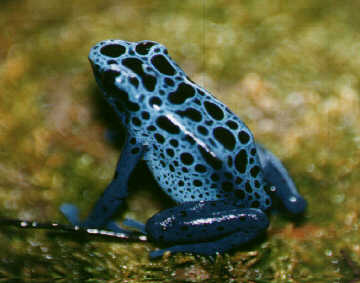 The
mating season, occurring after the rainy season has begun, is
signaled when sounds of buzzing, humming, chirping, or trilling can
be heard all over the forest. Males attract females through elaborate
calls, often after careful planning of the best place to store their
eggs until the tadpoles are ready to be placed in water. After
finding the male, the female deposits a few large eggs on a leaf that
is in close proximity of a body of water, the site that the male has
carefully decided on. Being near water insures that the eggs will
remain moist, which is essential to the tadpoles' growth and
development. The leaf usually hangs about 1.2 meters above the forest
floor. The male then fertilizes the eggs and is responsible for
guarding the eggs and making sure that they stay wet. After 2-4 weeks
the tadpoles are ready to be transported to water where they will
develop into adult frogs. Many times the male frog carries the
tadpoles on his back, which contains
The
mating season, occurring after the rainy season has begun, is
signaled when sounds of buzzing, humming, chirping, or trilling can
be heard all over the forest. Males attract females through elaborate
calls, often after careful planning of the best place to store their
eggs until the tadpoles are ready to be placed in water. After
finding the male, the female deposits a few large eggs on a leaf that
is in close proximity of a body of water, the site that the male has
carefully decided on. Being near water insures that the eggs will
remain moist, which is essential to the tadpoles' growth and
development. The leaf usually hangs about 1.2 meters above the forest
floor. The male then fertilizes the eggs and is responsible for
guarding the eggs and making sure that they stay wet. After 2-4 weeks
the tadpoles are ready to be transported to water where they will
develop into adult frogs. Many times the male frog carries the
tadpoles on his back, which contains 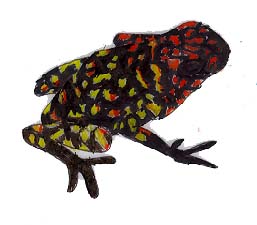 sticky
mucus, to a small accumulation of water. In some species the female
is responsible for transportation, and in a few species both the male
and female seek out the best sites for their baby tadpoles to
develop. Many times the parent frogs take each tadpole to a separate
place because the tadpoles are cannibalistic. How they remember the
multiple locations is still unknown. Good sites for developing
tadpoles tend to be bromeliad funnels, branches, hollow trees, and
bamboo stalks. One species even uses the rain filled "monkey
pots" found on the forest floor that are produced by Brazil nut
trees. The frogs feed the tadpoles unfertilized eggs about once every
five days and show parental care. After about 2-3 months, the
tadpoles have completely developed into adult frogs and are ready to
pass on their genes to yet another generation of poison dart frogs.
sticky
mucus, to a small accumulation of water. In some species the female
is responsible for transportation, and in a few species both the male
and female seek out the best sites for their baby tadpoles to
develop. Many times the parent frogs take each tadpole to a separate
place because the tadpoles are cannibalistic. How they remember the
multiple locations is still unknown. Good sites for developing
tadpoles tend to be bromeliad funnels, branches, hollow trees, and
bamboo stalks. One species even uses the rain filled "monkey
pots" found on the forest floor that are produced by Brazil nut
trees. The frogs feed the tadpoles unfertilized eggs about once every
five days and show parental care. After about 2-3 months, the
tadpoles have completely developed into adult frogs and are ready to
pass on their genes to yet another generation of poison dart frogs.
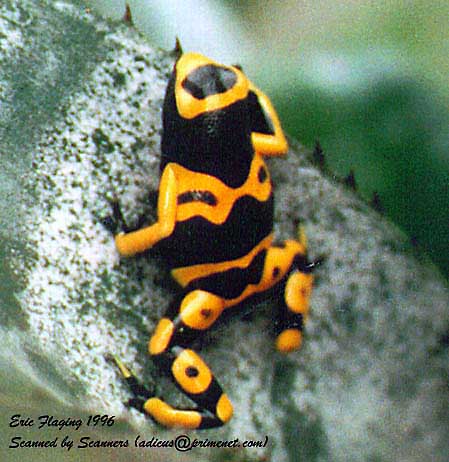 Although
usually found on the forest floor, dendrobates do have glandular
muscular adhesive bands on their toes which are almost exactly like
the tree frogs. The poison dart frogs secrete alkaloid poisons, which
are complex and bitter tasting. Alkaloid poisons, which include
caffeine, nicotine, cannabidiol, cocaine, and morphine, are some of
the most familiar and addictive drugs known to man. They tend to
interfere with liver and cell membrane function, and they can cause
cessation of lactation, birth defects, or abortion. Alkaloid
chemicals are harmful to numerous animals, and three species have
been found that can be harmful and even deadly to humans: Phyllobates
terribilis, Phyllobates aurotaenia, and Phyllobates bicolor.
Phyllobates terribilis is the most deadly poison dart frog with
enough toxin in one frog to kill 20,000 lab mice. Touching it can be
fatal to a human, especially if the toxins get into the bloodstream
through a laceration in the skin. The frogs do not have poison glands
on their
Although
usually found on the forest floor, dendrobates do have glandular
muscular adhesive bands on their toes which are almost exactly like
the tree frogs. The poison dart frogs secrete alkaloid poisons, which
are complex and bitter tasting. Alkaloid poisons, which include
caffeine, nicotine, cannabidiol, cocaine, and morphine, are some of
the most familiar and addictive drugs known to man. They tend to
interfere with liver and cell membrane function, and they can cause
cessation of lactation, birth defects, or abortion. Alkaloid
chemicals are harmful to numerous animals, and three species have
been found that can be harmful and even deadly to humans: Phyllobates
terribilis, Phyllobates aurotaenia, and Phyllobates bicolor.
Phyllobates terribilis is the most deadly poison dart frog with
enough toxin in one frog to kill 20,000 lab mice. Touching it can be
fatal to a human, especially if the toxins get into the bloodstream
through a laceration in the skin. The frogs do not have poison glands
on their  feet.
feet.
The alkaloid toxins affect muscles and nerves, many times causing
respiratory and heart failure. The Chaco Indians of western Columbia
use these frogs in hunting by placing the toxins on the tips of
arrows or darts. The tribes boil the frogs and then dip the darts in
the poison, or they hang the frogs over a fire by forcing a sharp
stick into their mouths. The heat causes the poison to moisten the
back of the frog in the form of a white froth, making it easy to get
on the tip of a dart. One frog can produce enough toxins to coat
50-100 arrows, and the darts remain toxic for about 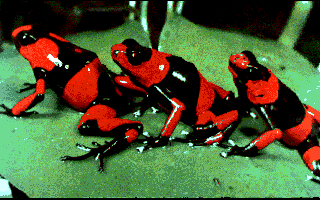 a
year. The Indians use the darts to kill spider and howler monkeys,
as well as other small animals. The batrachotoxin, the most toxic of
the alkaloids, can aid in the hunting of jaguars, deer, and birds.
Frogs of the species Phyllobates terribilis do not have to be killed
for their poison. The Indians just rub the darts on their backs and
the poison is secreted. Studies of the toxins from different species
have shown that frogs of similar species have vastly different
alkaloid chemicals.
a
year. The Indians use the darts to kill spider and howler monkeys,
as well as other small animals. The batrachotoxin, the most toxic of
the alkaloids, can aid in the hunting of jaguars, deer, and birds.
Frogs of the species Phyllobates terribilis do not have to be killed
for their poison. The Indians just rub the darts on their backs and
the poison is secreted. Studies of the toxins from different species
have shown that frogs of similar species have vastly different
alkaloid chemicals. 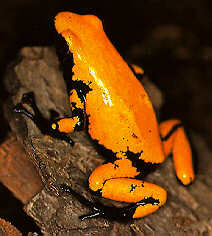 Research
has found about 300 new alkaloids in poison dart frogs.
Batrachotoxin has allowed scientists to study sodium channels, which
are responsible for regulating the excitation of nerve cells. Other
toxins help us to understand more about how local anesthetics work.
Epibatidine, one alkaloid chemical, has been proven to numb more
efficiently than morphine. Better anesthetics are always being sought
out to decrease the risk of post- anesthetic problems. Pharmaceutical
research has also looked at the uses of these new toxins as muscle
relaxants, heart stimulants, heart regulators, and anesthetics.
Research
has found about 300 new alkaloids in poison dart frogs.
Batrachotoxin has allowed scientists to study sodium channels, which
are responsible for regulating the excitation of nerve cells. Other
toxins help us to understand more about how local anesthetics work.
Epibatidine, one alkaloid chemical, has been proven to numb more
efficiently than morphine. Better anesthetics are always being sought
out to decrease the risk of post- anesthetic problems. Pharmaceutical
research has also looked at the uses of these new toxins as muscle
relaxants, heart stimulants, heart regulators, and anesthetics. 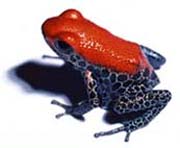
Unfortunately, research on the possibilities of the poison dart
frogs' secretions is limited because these frogs are currently on the
threatened list due to the rapid destruction of their habitats.
Obtaining these species is getting difficult because frogs in
captivity seem to loose their toxic secretions probably due to
environmental and dietary changes. Scientists have recently been
exploring the possible link between the frogs' diet of ants and the
ability to produce alkaloid Red Back Frog poisons. More alkaloids are
found in ant species than in any other group of insects, and it has
been observed that ants comprise from 50-73% of the Poison dart
frogs' diet. Further research has shown that other non-toxic frog
species have diets with only about 12-16% ants. The consumption of
ants that contain alkaloid compounds may be the primary character
that led to the development of toxic skin and the radiation of
poisonous species. Researchers are now trying to find ways of raising
ant species to feed frogs in captivity in hopes that someday the
captive frogs can produce enough alkaloid substances for more
substantial findings.  Without
these toxins being produced in large accessible quantities, research
can be minimal at best.
Without
these toxins being produced in large accessible quantities, research
can be minimal at best.
Without measures to protect their natural habitats, the poison dart frogs may become extinct. Their extinction will decrease the diversity of animal life and prevent many new chemicals from being discovered. These new chemicals could provide biomedical researchers with information that will help to develop drugs that can be extremely important to humans. Saving the frogs' natural habitat will prove to be beneficial to everyone. Who knows.... one day, your life may literally be saved by a frog!